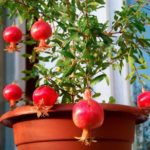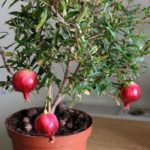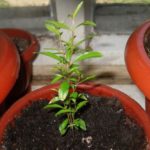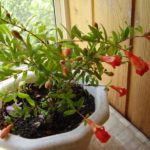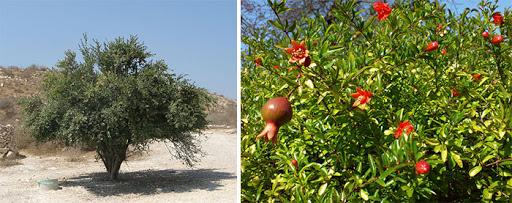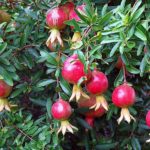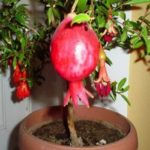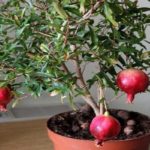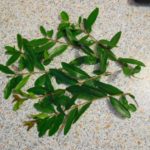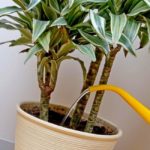Indoor pomegranate is an exotic plant that can also be grown under artificial conditions. It blooms profusely and produces delicious edible fruits. Let's consider growing the dwarf Carthage pomegranate from seeds at home, its advantages and disadvantages. When and how to plant, how to care for, and propagate plants. How to harvest and store pomegranates.
- General description and characteristics of the dwarf Carthage garnet
- Pros and cons of the variety
- How to grow it correctly?
- Best time to plant
- Soil preparation
- Landing algorithm
- Cultivation care
- Lighting and temperature conditions
- Formative pruning
- Watering
- Diseases and pests
- Plant propagation
- Harvesting and storing pomegranate harvest
General description and characteristics of the dwarf Carthage garnet
In room conditions, the Carthage pomegranate grows small in size, in the form of a tree up to 0.8 m in height. The leaves are light green, small, the flowers are red, large, single or collected in loose inflorescences. The first season the plant blooms only with barren flowers. Hand pollination is required for fruit set. Pomegranates are 6-7 cm in diameter, juicy, with a sour taste. 5 fruits are left on the tree.
They ripen by mid-winter, turning dark red and orange. In autumn the foliage falls and a short dormant period ensues.
Pros and cons of the variety
Despite the minor disadvantages of the variety, Carthage pomegranate is readily grown indoors.
How to grow it correctly?
In order for the Carthage pomegranate to grow well and bear fruit successfully, you need to choose the right container, substrate and plant the plant. Its further development depends on this.
Best time to plant
Carthage pomegranate is planted in the spring, when daylight hours begin to increase. Under such conditions, the plant takes root more easily.
Soil preparation
For pomegranate, select a nutrient soil mixture that is loose, soft, air- and moisture-permeable. The reaction should be neutral. You can use a ready-made substrate for begonias or roses.
Landing algorithm
A layer of expanded clay drainage is placed at the bottom of the container, through which excess moisture will be removed from the pot.
Up to 3 years, the pomegranate is transplanted every year into a slightly larger pot. Providing sufficient living space is important, since in a cramped container the pomegranate develops and blooms worse. Then the transplant is done every 3 years. Transplanted using the transshipment method.
Cultivation care
Pomegranate is a rather fastidious crop that requires constant attention and care. For the well-being of the plant, it is important to maintain optimal conditions of humidity, temperature, and light. Properly water and fertilize the tree. Carry out pruning.
Lighting and temperature conditions
The pot of Carthage pomegranate is placed in a lighted place. If there is a lack of light, the plant may not bloom. In summer you can take the container outside and in winter keep it in the greenhouse.
If the air is dry, the plant is sprayed with a spray bottle. The temperature from spring to autumn should be approximately 20-25 ˚С, during the rest period and winter - 5-10 ˚С lower.
Formative pruning
The indoor Carthage pomegranate is trimmed to give it the desired shape and limit growth. Young branches are pinched, woody ones are cut with pruning shears. The tree is formed from 5-6 skeletal branches, shoots of 2-3 orders will bear fruit.
Watering
Water the Carthage pomegranate moderately so that the substrate in the root zone remains moist. Watering a flowering plant is reduced, and after flowering is over, it is increased again to the previous level. During the dormant period, watering should be minimal - once every 2 months.
Signs of lack of moisture are wilting and curling of leaves. In damp and cold soil, roots can begin to rot and ripening fruits can crack. Fertilize once a month with a solution of ready-made complex fertilizers; when the plant is resting, do not fertilize.
Diseases and pests
Scale insects and whiteflies can appear on Carthage pomegranate at any time of the year. If they have not yet had time to reproduce, you can collect them manually. If this does not help, use insecticides. When placed in a room with dry air, pomegranates are colonized by spider mites. Among the fungal diseases, pomegranate is affected by powdery mildew, the control measures for which are treatment with a fungicide.
If the roots have rotted due to overwatering, you should immediately transplant the plant into another pot with dry substrate.
Plant propagation
The germination rate of pomegranate seeds is low, so you need to sow several pieces. Select seeds from large, ripe, healthy fruits. Sowed in April, when the first 2 leaves appear, the seedlings are transplanted into pots. Water to keep the soil moist. Temperature is above 25˚С.
In addition to the seed propagation method, cuttings are used. Cuttings of 4-5 buds are cut from a fruiting tree. They are treated with a root formation stimulator, planted obliquely in a moist substrate, and covered with film or a jar. Ventilate and moisten the top layer of the substrate every day. The rooted cuttings are planted in a pot after 3 months. If the cuttings bloom, the flowers are cut off.
Harvesting and storing pomegranate harvest
The Carthage pomegranate, grown from cuttings, begins to bear fruit at 3-4 years, and from seeds at 6-8 years. The fruits are harvested when ripe, when the skin acquires the color characteristic of the variety. Store in the refrigerator in the vegetable compartment for 2-3 months.
Carthage pomegranate requires careful care, starting from the day of planting. Its development and fruiting depend on temperature and humidity conditions, lighting, watering and fertilization. If grown correctly, the tree will not only bloom luxuriantly every season, but you can also harvest delicious homemade pomegranates from it.

